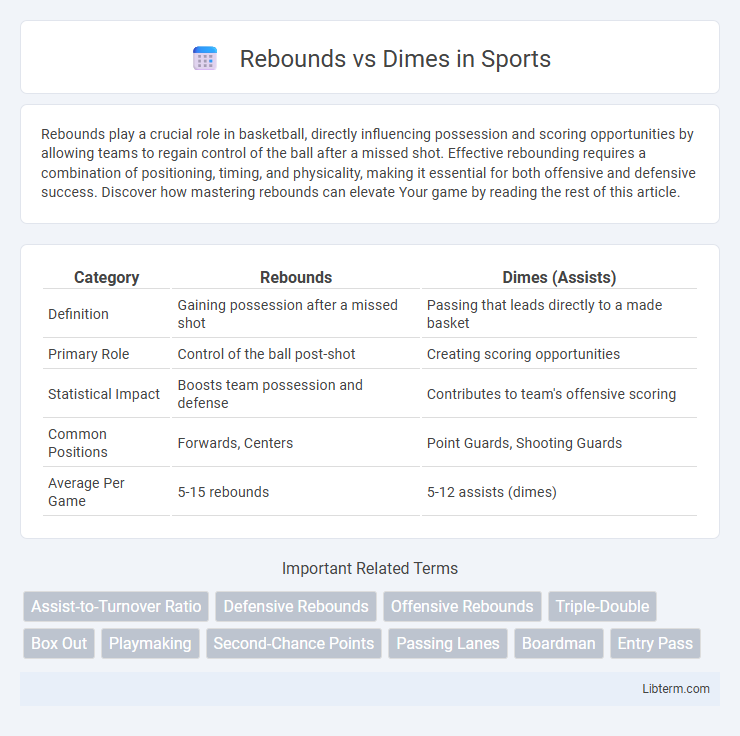Rebounds play a crucial role in basketball, directly influencing possession and scoring opportunities by allowing teams to regain control of the ball after a missed shot. Effective rebounding requires a combination of positioning, timing, and physicality, making it essential for both offensive and defensive success. Discover how mastering rebounds can elevate Your game by reading the rest of this article.
Table of Comparison
| Category | Rebounds | Dimes (Assists) |
|---|---|---|
| Definition | Gaining possession after a missed shot | Passing that leads directly to a made basket |
| Primary Role | Control of the ball post-shot | Creating scoring opportunities |
| Statistical Impact | Boosts team possession and defense | Contributes to team's offensive scoring |
| Common Positions | Forwards, Centers | Point Guards, Shooting Guards |
| Average Per Game | 5-15 rebounds | 5-12 assists (dimes) |
Understanding Rebounds and Dimes in Basketball
Rebounds in basketball refer to the act of retrieving the ball after a missed field goal or free throw attempt, crucial for gaining possession and creating additional scoring opportunities. Dimes signify assists, where a player passes the ball leading directly to a made basket, emphasizing teamwork and playmaking skills. Understanding the balance between rebounds and dimes highlights a player's dual impact on both offense and defense, reflecting their versatility and contribution to the team's overall performance.
Key Differences Between Rebounds and Dimes
Rebounds measure a player's ability to recover missed shots, reflecting defensive and offensive presence on the court, while dimes track assists, highlighting playmaking and teamwork skills. Rebounds contribute to possession control and scoring opportunities, whereas dimes indicate a player's vision and passing accuracy in facilitating scoring. Understanding these statistics helps evaluate a player's overall impact, with rebounds emphasizing physicality and dimes showcasing offensive creativity.
Impact of Rebounds on Game Momentum
Rebounds significantly influence basketball game momentum by enabling teams to control possession and initiate fast breaks, often resulting in high-percentage scoring opportunities. Securing offensive rebounds extends possessions, increasing scoring chances, while defensive rebounds halt the opponent's offensive flow, disrupting their rhythm. Effective rebounding shifts momentum by energizing the team, boosting confidence, and applying pressure on the opposing defense.
How Dimes Shape Team Offense
Dimes, or assists, play a crucial role in shaping team offense by facilitating ball movement and creating high-percentage scoring opportunities. Players who excel in distributing the ball effectively enhance team cohesion and increase offensive efficiency through precise passing that leads directly to made baskets. This unselfish playstyle amplifies scoring potential and helps maintain consistent offensive pressure against defenses.
Top Players Known for Rebounds
Rebounds are a critical statistic in basketball, highlighting players' ability to control the ball after missed shots, with top rebounders like Andre Drummond, Dennis Rodman, and Rudy Gobert leading historical and current leaderboards. These athletes excel in positioning, timing, and physicality, often securing double-digit rebounds per game, significantly contributing to their teams' defensive and offensive possessions. Rebounding dominance is a key factor in game control, making these players invaluable for their impact on possession and momentum.
Leading NBA Players in Dimes
Leading NBA players in dimes dominate playmaking by consistently delivering high assist numbers, with Chris Paul averaging over 9 assists per game in the 2023 season. Their ability to read defenses and create scoring opportunities sets them apart from top rebounders who primarily control possession and physicality near the basket. While players like Rudy Gobert excel in rebounding with averages around 15 boards per game, elite passers shape offensive flow through precision passing and court vision.
Rebounding Skills vs. Passing Skills
Rebounding skills involve positioning, timing, and physicality to secure missed shots, emphasizing anticipation and vertical leap. Passing skills require court vision, decision-making, and precision to distribute the ball effectively, creating scoring opportunities for teammates. Mastery of rebounding maximizes possession while superior passing enhances team offense efficiency.
Rebounds vs Dimes: Statistical Analysis
Rebounds and dimes are critical basketball metrics often analyzed to evaluate player performance and team dynamics. Statistical analysis reveals rebounds contribute significantly to possession control, while dimes, or assists, indicate playmaking efficiency and team coordination. Advanced metrics such as rebound percentage and assist-to-turnover ratio provide deeper insights into a player's impact on both ends of the court.
Strategies to Improve Rebounds and Dimes
Improving rebounds requires positioning near the basket, anticipating shot trajectories, and using physicality to box out opponents effectively. Enhancing dimes depends on vision, timing, and understanding teammates' movements to deliver precise passes that create scoring opportunities. Incorporating drills that focus on hand-eye coordination, spatial awareness, and quick decision-making can significantly boost both rebounding and assist skills in basketball.
Rebounds and Dimes: Which Matters More?
Rebounds and dimes both play crucial roles in basketball, but rebounds often have a greater impact on controlling the game by providing extra possessions and limiting opponents' scoring opportunities. While dimes, or assists, facilitate teamwork and efficient offense, the ability to secure rebounds directly influences a team's defensive and offensive balance. Statistical analysis frequently shows that teams excelling in rebounding typically enjoy higher win percentages, underscoring the premium value of boards over assists in many competitive scenarios.
Rebounds Infographic

 libterm.com
libterm.com